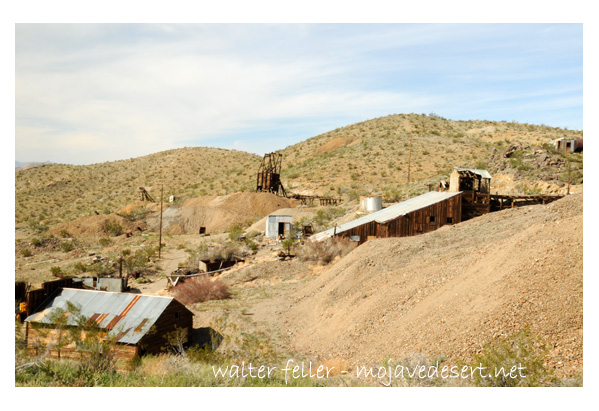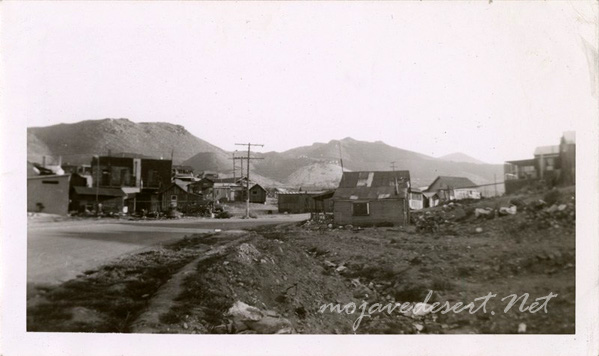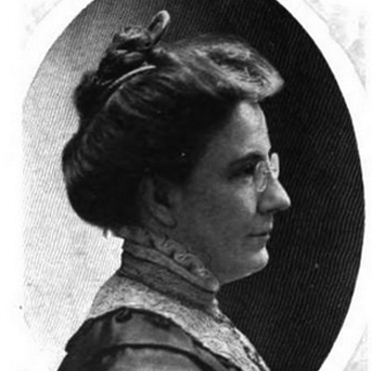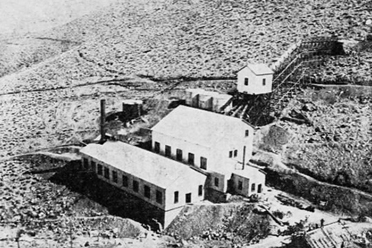Kern County:
Randsburg Mining District

Wandering prospectors from the El Paso District discovered that the Summit Range, located northeast of the El Paso Mountains, also contained placer values and began to dry wash for gold there in the early l890s. No more than 100 men lived at Summit Dry Diggings, a tent and dugout camp. Supplies came in from Goler and water from El Paso (Willow) Spring. At least two prospectors from the Summit Dry Diggings, Frederic Mooers and William Langdon, ventured south to explore the Rand Mountains in 1894. Finding only traces of gold, they returned, content at the time to work what seemed to be richer earth.
Frederic Mooers never forgot what he found on Rand Mountain, and a year later was startled into taking a closer look at his earlier find. A group of miners, displeased with the scant returns from their present claims, were talking of looking into that ground on Rand Mountain that he and Langdon had discovered earlier. Concerned with the thought of outsiders cashing in on a find that was his, Mooers planned his own trip.
Mooers and his new partner, John Singleton, decided to take a careful and well-planned look. This required a wagon and team to carry their mining equipment and camping supplies. Charles Burcham was one of the few citizens of the camp endowed with a vehicle and animals, thus the partnership became a trio. The three left camp without informing anyone where they were going, and faked a heading to Goler. Once out of sight of camp, Burcham swung his team south and up the gentle grade to the Rand Mountains. After prospecting the sandy gullies, Burcham and Singleton climbed to the top of a red stained peak, while Mooers stayed in camp. Singleton knocked off a specimen with his hammer and turned it over to see the freshly broken side. Singleton was a carpenter, with little prospecting experience, yet what he saw caused him to yell for Burcham. Burcham, nearing the end of a two-year prospecting adventure financed by his wife, Dr. Rose La Monte Burcham, took one look at the rock and exclaimed, "We're rich! By George, Singleton, we've found it!" 20
The partners originally entitled their discovery the Rand mine, but later changed it to the Yellow Aster. The former name was frequently misused in stock promotions and in describing the whole district (i.e. the Rand mines). The Yellow Aster was chosen because Mooers was reading a pulp novel by the same name at the time his partners approached him about a name change. Reflecting upon the inspiring view of wild flowers he had seen while prospecting, Mooers suggested the Yellow Aster, and it stuck.
On April 25, 1895, Mooers, Singleton and Burcham staked their claims. The location work was rushed because the three realized that a discovery like theirs could not be kept quiet long. Hadn't a group already made plans to come even before Mooers got the idea? Keenly aware of the importance to properly record their ground before a rush could get started, Burcham devised a clever scheme that bought them a few days extra time. Fearful that miners from the Summit Diggings would soon be over to investigate their activity, the trio postponed any fancy celebrations until the mine was safely recorded and legally theirs. Instead, Burcham loaded a couple of sacks with worthless iron stained bull quartz, threw them in his wagon and rode to the water hole. Curious miners asked if he had found anything worthwhile. He stubbornly admitted, "Well, I just don't know. But I think we've found something pretty good." He volunteered no more, but inquisitive miners soon found the planted sacks while Burcham was away from the wagon. It soon spread throughout camp that three fools were digging bull quartz. Burcham had the extra day or two he and his partners needed.21
With the location work complete in June of 1895, Burcham returned to his wife in San Bernardino to report the good news, and to turn over one-half of his one-third interest to her to pay off the grubstake. She strongly counseled him not to sign any document until the true value of the mine could be determined. Her advice saved the Yellow Aster's discoverers from the usual fate of selling out too soon and too low. Having existed on bacon and beans for months, if not years, those lucky prospectors who do stumble on a real bonanza are overwhelmed upon receiving offers of $3,000 to $20,000 from someone with a large sum of ready cash. To one so used to scratching out a living, an offer of $3,000 to most prospectors of the past has been a huge temptation, often equivalent to 3 years wages as a miner. And if $3,000 was a huge temptation, $20,000 was unbelievable, and $500,000 was beyond anyone's wildest imaginations.
Mooers and Singleton were giving in to this common temptation while Burcham was away in San Bernardino. O. B. Stanton promised to open and develop the mine, construct a ten stamp mill, and spend $10,000 doing it in return for a 30 day option in a half interest in the mine and an option to purchase the entire property at any time before December for $500,000.
Stanton had the signatures of Mooers and Singleton on an agreement dated June 22, 1895, but upon his return, Burcham remembered his wife's advice and refused to sign. The agreement later caused the discoverer-owners numerous legal headaches. Even William Langdon claimed a piece of the Yellow Aster by virtue of his being present with Mooers a year prior to the discovery when he only found traces of gold. The Yellow Aster went on to produce over $12,000,000 in gold, more than enough to pay for all the litigation and give the owners a handsome profit. Yet in July, 1895, Burcham was bemoaning that so much could be accomplished if only they had $500.
Worried about the temptation of selling short, and having been strongly bitten by the gold bug herself, Dr. Burcham closed up her practice and traveled to Rand Mountain in July of 1895. She adapted to the rigors of camp life quickly, and was soon cooking for the men in the camp while they dry washed placer ground and crushed high-grade ore in mortars.
The men left much of the business details to Dr. Burcham and she became bookkeeper and secretary. When the Yellow Aster Mining and Milling Company opened their account with the National Bank of California in Los Angeles, two signatures were required: that of John Singleton (president) and R. L. Burcham. Later the men were to bemoan that at times she ran too tight a ship, yet it was her advice and dominance that kept the Yellow Aster under the control and ownership of it's original discoverers.
Pat Reddy, a local lawyer, approached Dr. Burcham once in high hopes of being able to buy or bargain for some of the Yellow Aster holdings. She turned him down cold, and he returned to Mojave swearing he'd never have anything to do with a woman again. Later Reddy gained a partial interest in the mine by offering his legal services, and he had to use his law skills against the Yellow Aster when Dr. Burcham took him to court to pay him off and regain control.22
In July of 1895, when the Yellow Aster Mining and Milling Company began to fully understand the magnitude of its bonanza, other prospectors and promoters began to share the fever. Ed Maginnis and J. T. O'Leary, along with a fellow named Hansen, were busy one mile due west of the Yellow Aster staking their location notices on a claim called the Minnehaha. Soon, a tent city, Pioneer Camp, grew up at the foot of the draw leading up to the Yellow Aster. The first frame building was erected October, 1895, and was used as a post office. The second frame building was Starkey's saloon.23
On December 20, 1895, the Rand Mining District was organized. Twenty-six persons signed the document creating this district out of the Summit Range District. Randsburg had 13 buildings at the time, mostly tents. Ed Maginnis was elected recorder by a margin of one vote. In 1897 he was appointed Justice of the Peace by the Kern County Board of Supervisors, and he retired from that office in October, 1935.
The Randsburg rush was in full swing by 1896 when the Ashford brothers discovered the King Solomon Mine, and the Ramie brothers staked out the Butte Mine. The Baltic was discovered by William and Wilson Logan in January, 1896. The Sunshine, and Operator Divide mines also came into being that year, as did the Pioneer Liquor and Gentlemen's Furnishings Store and Mrs. Kern's Miner's Hotel. George Clover started printing the Randsburg Miner in 1896, and that fall 686 voters cast their ballot in Randsburg. By December the population was 1,500, up 33 percent since that summer. Randsburg boasted 50 frame buildings by the end of 1896, and the St. Elmo Hotel was feeding 400 persons a day and lodging 100 a night.24
The Little Butte and Santa Ana Group mines were discovered In 1897 and Randsburg received its first mill in March of that year. The two-stamp mill of John Quinn and George Pridham was located two blocks from the center of town and could crush 10 tons a day. With such small capacity, most of the Randsburg District ore was shipped to Garlock for processing until 1898. At that time the completion of the Randsburg Railway made it more economical to ship ore to the Barstow Reduction Works. In addition to the mill, Randsburg received its first church and bank in 1897.25
By October, 1897, it was reported that the Rand District had produced over $600,000 in gold. Also, the Randsburg Railway was nearing completion as a standard gauge line running 28 miles from the Santa Fe line at Kramer to within one mile of the Yellow Aster. The Randsburg Railway Company was incorporated May 18, 1897, with John Singleton as a member of the board of directors. The Randsburg Railway began operation January 17, 1898. Two days later fire struck Randsburg. Businessmen and citizens rebuilt the town on the smoldering remains, only to be smitten again on May 6. After each fire, buildings were rebuilt a little bit further apart than before. Although water was available, dynamiting buildings was the most effective and exciting means of fire control. On at least one occasion careless firemen lit a bundle of dynamite under a house, only to find a small boy still on the premises. Quick action saved the boy. Another time, a well-stocked hardware store became the candidate for dynamiting, and the explosion caused a shower of dishes, pots, pans and washtubs to rain down on that part of town.26
Randsburg soon became one of the great boomtowns of the West. In fact it even enjoyed the luxury of having a neighboring town rival. In December of 1896, when Randsburg was little more than a cluster of tents, the Johannesburg Water and Townsite Company was busy laying out a Christmas present for its neighbor, a rival town (Johannesburg) that would be well-planned, even to having piped water in the homes.
Johannesburg at its height had a post office, two general stores, a real estate office, stationers and variety store, billiard-pool room, music hall, boarding houses, lunch counter, two laundries, two lumber yards, two livery stables, a barber shop, telegraph line with Mojave, and a telephone exchange with Randsburg. This greatly facilitated courting between the two towns, yet the party lines gave such unequalled privacy that two lovebirds found their conversations the subject of printed inquiries by the Randsburg Miner as to who had been making love to whom over the phone.27
Johannesburg got a golf course in 1900. It began at the Red Dog Mill and ran around town, crossing the railroad twice, and ending where it began. Sporting 9 greens, the course was used by a golf club having 13 members, 7 of them ladies. The Randsburg Miner saluted its neighbor with the words "Johannesburg is an up-to-date town". Miners from as far away as Pleasant Canyon and Ballarat could now enjoy a weekend of golf, stay at the Hotel Johannesburg, and board W. K. Miller's stage on Monday for the trip back to work.28
In the Spring of 1898 the Yellow Aster Mining and Milling Company purchased the Skillings Well east of Johannesburg. The mine owners proposed laying a 5 inch pipeline to Randsburg, with a pumping plant to push the water over Gold Hill, a low ridge between the two towns. While Randsburg bought her water by the gallon or barrel ($2 a barrel delivered in town, 40 cents at the well) Johannesburg had several water companies (Squaw Springs and Johannesburg Milling and Water Company, among others) and piped water. In patient expectation of the arrival of piped water to Randsburg, the Citizen's Committee saw to it that fireplugs were placed and a pipeline laid. Randsburg also bought a chemical fire engine from Bodie, a gold mining camp in Mono County, California. 29
Ore from the Yellow Aster was worked at the Barstow Reduction Works after January, 1898, when the Randsburg Railway became operational. The shipped ore averaged $40 to $50 per ton. Lower grade ore was being kept on dumps at the mine site to be run once the Yellow Aster mills were completed. Yellow Aster dividends for April, May and June totaled $24,000. On July 2, the Randsburg Miner reported the Yellow Aster as having produced $350,000 in bullion. Plagued by highgrading, the Yellow Aster announced in the summer of 1898 it was erecting a changing room to discourage the habit of pocketing away in one's clothes an exceptionally rich piece of ore.30
Although the Yellow Aster dominated Randsburg, other mines were being found and developed. The Big Gold Mine was discovered in 1898, and three years after the discovery of the Butte Mine, the Butte Lode Mining Company was formed in 1899. It had produced $140,000 during those 3 years and later went on to produce a total of two million dollars in gold and silver. 31

Historic photo of Randsburg circa 1916
Randsburg's population reached 3,500 in early 1899, and by year's end the Yellow Aster employed 150 men and had a $13,000 monthly payroll. Underground miners were paid $3 a day and those topside received $2.50. Early the next year a pumping plant was finished at Goler, forcing water up an 8-mile grade to Randsburg in preparation for the completion of the Yellow Aster's 100-stamp mill.32
Singleton, Mooers, and the Burchams began to enjoy their wealth. Mrs. Burcham began planning a trip to Europe, while her husband invested in mining interests over a wide territory. All three men wore handsome watch chains, stickpins, and jewelry made from Goler nuggets. While Mooers died in the spring of 1900, never having been completely healthy for years, the others enjoyed the level of affluence that comes to the very fortunate in mining.33
Around Christmas of 1901, smallpox broke out in Randsburg, and before it was contained over 500 cases appeared in the vicinity. However, this was only a minor setback in the development of the California Desert's largest mining town, and soon production soared to new heights. The Yellow Aster's new 100 stamp mill was completed in 1902, producing gold worth $100,000 a month. With the new mill in operation, the older 30 stamp mill was used to treat only the higher grade ores. Both mills ran 24 hours a day. In the 100-stamp mill, consisting of 20 batteries of 5 stamps each, 4 batteries a week would be shut down and cleaned up. This allowed each stamp to be run at least a month between cleanups. Two men handled the amalgamation process, each in charge of 50 stamps. With a 12 hour shift, a man would make $4.50 per day, and many worked 7 days a week, holidays included. Nevertheless, when fire struck town, the mine and mills closed down completely, and everyone fought the flames on company time.34
Labor troubles erupted at the Yellow Aster in 1903. The Yellow Aster didn't need any state help to break the strike, but labor dissatisfaction persisted throughout the next 15 years, and several mysterious acts of mischief were noted. Chief among these was a fire that broke out in town 2 days after the miner's union went on strike. It was soon discovered that the fire hose and rope to the firebell had been cut, and the water turned off. 35
Desert Fever - Vredenburgh - Harthill

Rose Lamont Burcham - 1910
Yellow Aster
Geomorphic Province
EcosubsectionsSearles Valley - Owlshead Mountains
Randsburg, Ca.
Atolia-Randsburg Tungsten

Yellow Aster